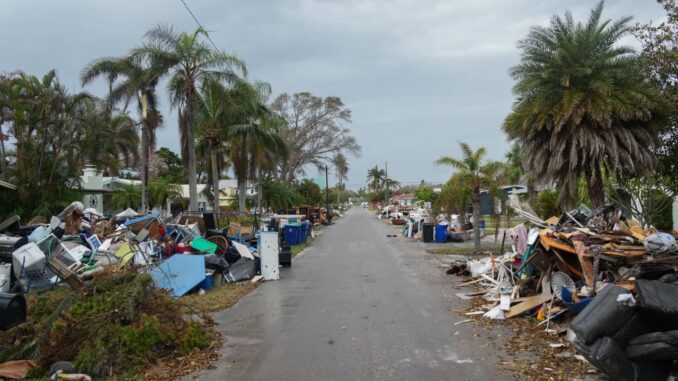
In the week after Hurricane Helene hit Florida, while Hurricane Milton was still churning its way toward the state, one St. Petersburg homeowner listed their waterfront home directly on Tampa Bay for $6.25 million.
The home, located in the affluent Venetian Isles area, sits nine feet above sea level, and had escaped any damage during Helene even as many of its neighbors were flooded.
“We strategically listed that house,” said listing agent Sara Howe of Compass. “We thought there would be some buyers in the same neighborhood that did flood, and that are going to need new houses and are going to stay on the water.”
The aftermath of Helene and Milton, which brought historic storm surges to Florida’s Gulf Coast and wreaked havoc across seven states, is bound to create ripples within the affected housing markets as homeowners weigh whether to rebuild or relocate, depending on the cost, extent of the damage and how prepared they were for this eventuality.
In this case, many homeowners affected might have been newcomers to the area, as migration to the Southeast has skyrocketed over the last several years. The storms certainly will cause a short-term disturbance, but it’s unclear to what extent they will have a long-term effect on the market.
In fact, migration to both Florida and North Carolina, two of the hardest hit states, had already been dropping off before September, but more so in Florida.
The share of property searches from out-of-state residents looking for homes in the Sunshine State was 40.5% in the third quarter, down 6.7 percentage points from the previous year, and roughly in line with pre-pandemic levels, according to an analysis by Realtor.com. Interest in Florida had been trending downward since late 2022, after close to three years of growth.
“All of the attention that Florida was given during the pandemic has really fallen as the market adjusts to price levels and the kind of inventory that buyers are willing to pay for,” said Realtor.com economist Hannah Jones. “Right now, it seems like prices are too high for buyers to have more interest.”

In North Carolina, interest from out-of-state buyers remains elevated, with more than half (56.5%) of all listing views coming from out of state in the third quarter, down 3.5 percentage points from last year’s peak, per the data. North Carolina’s trajectory differed from Florida in that out-of-state interest built momentum through the early 2020s, saw a major spike in the summer of 2022, and has remained elevated since, dropping off only slightly last quarter. Out-of-state interest remains about 50% higher than where it was in 2019.
“Both Florida and North Carolina have seen out-of-state viewership fall lately, but Florida has seen a sharper drop,” said Jones. “North Carolina has really sustained popularity with out-of-state shoppers.”
Though weather might be a factor for some home buyers, it’s possible that Florida’s fall from grace has more to do with housing costs, said Jones. “It is likely that out-of-state demand has dried up due to high home prices,” she said. “Climate-related risk and the resulting insurance costs may factor into waning demand in Florida by making it even more expensive to own in the state beyond a home’s sticker price.”
All major markets in Florida have seen inventory flood the market over the past year, with active listings up 36% statewide in August compared with last year, and more than 40% in Orlando, and Tampa, according to Redfin. That’s true in most markets nationwide, including in North Carolina, where inventory was up 21% in August, per Redfin. Buyers remain unwilling to enter the market at current pricing levels. In 2023, home sales were at the lowest volume since 1995, and this year is on track to be even worse, according to sales data from the Mortgage Brokers Association.
Other popular Sunbelt destinations have also seen interest level off, particularly Texas, where the share of out-of-state shoppers was 26% in the third quarter, down 7.2 percentage points from the previous year. Georgia and Colorado also saw out-of-state interest drop by roughly 7 percentage points in the third quarter. In South Carolina, the share of out-of-state interest was above 70%, still down slightly from last year.
As migration patterns change, many Americans are moving into areas with higher climate risks, including flood and wildfire risk, largely because that’s where a lot of cheaper housing is available. But as climate disasters increase, some shoppers are starting to take extreme weather into account.
In a survey taken after Helene, nearly one-third of young adults said the storm made them rethink where they’d like to live in the future, as did 15% of respondents over the age of 34, according to Redfin.
But the damage in North Carolina illustrates that climate disasters may not always play out as expected. “In terms of climate risk, North Carolina is not typically on the list of places that are considered super at risk in the same way Florida, and possibly Texas are,” said Jones.
For Floridians, on the other hand, this may be par for the course. “Two days after the storm, the sun comes out, and everybody’s working on their house and getting things back together,” said Howe.
In fact, she is expecting a surge of new construction, given that many displaced homeowners will need a place to live, and they’ll probably want homes built to the new city code, which requires homes to be at least 13 feet above sea level.
“I think that’s going to be a big boom,” she said. “I’ve got a couple of builders I’m working with and they’re quickly trying to put up new construction. I think we’ll see a lot of that in the coming years.”
Leave a Reply
You must be logged in to post a comment.